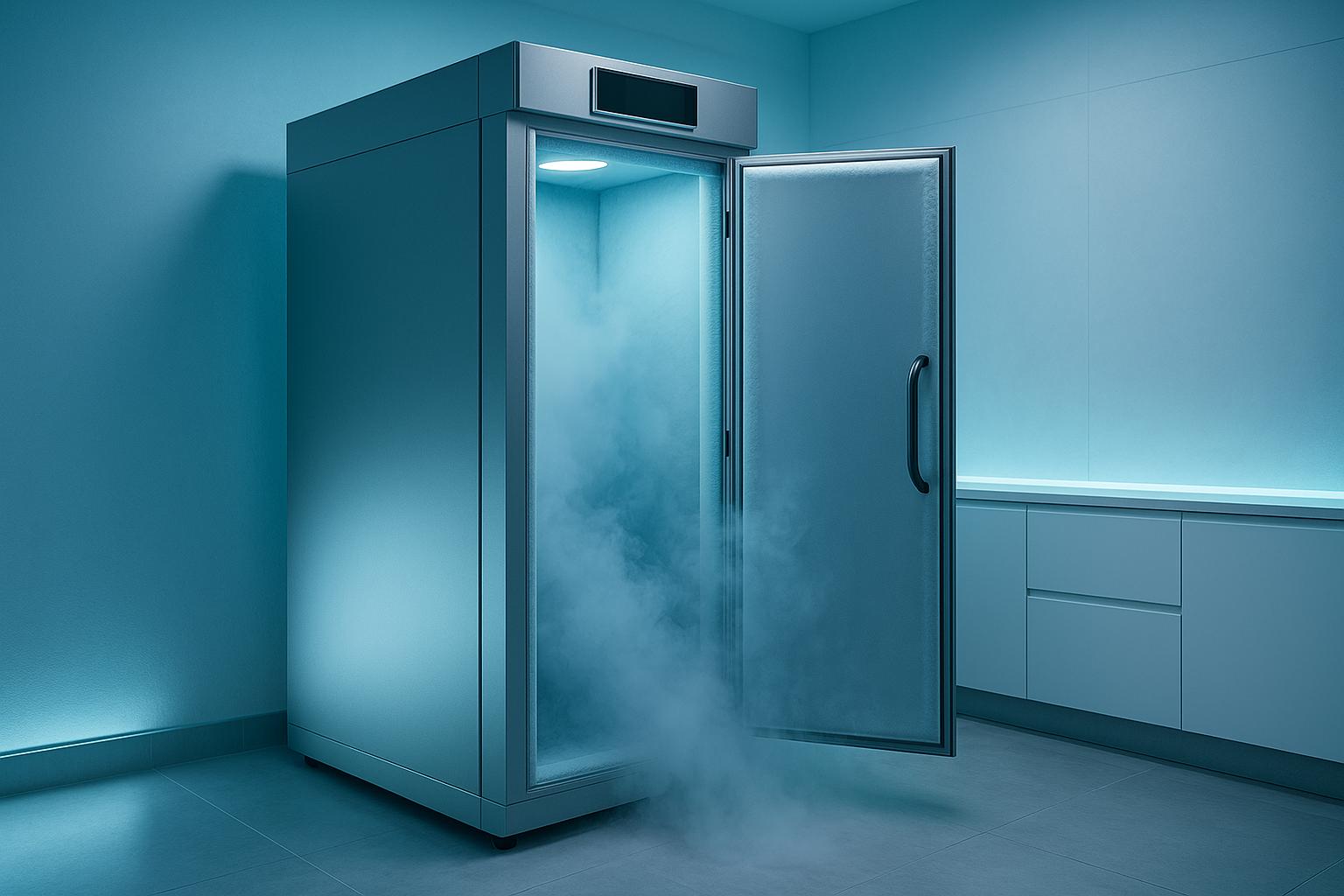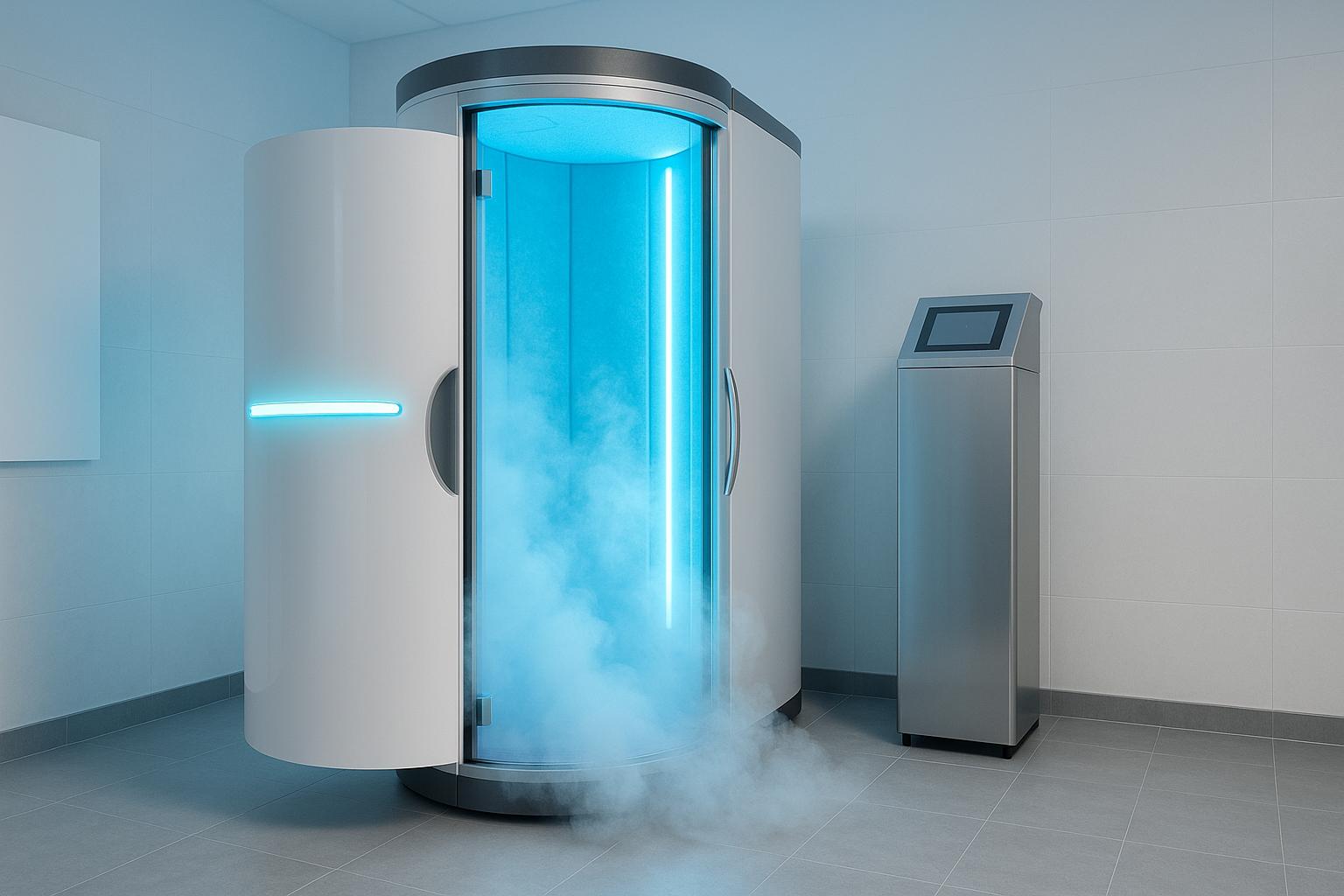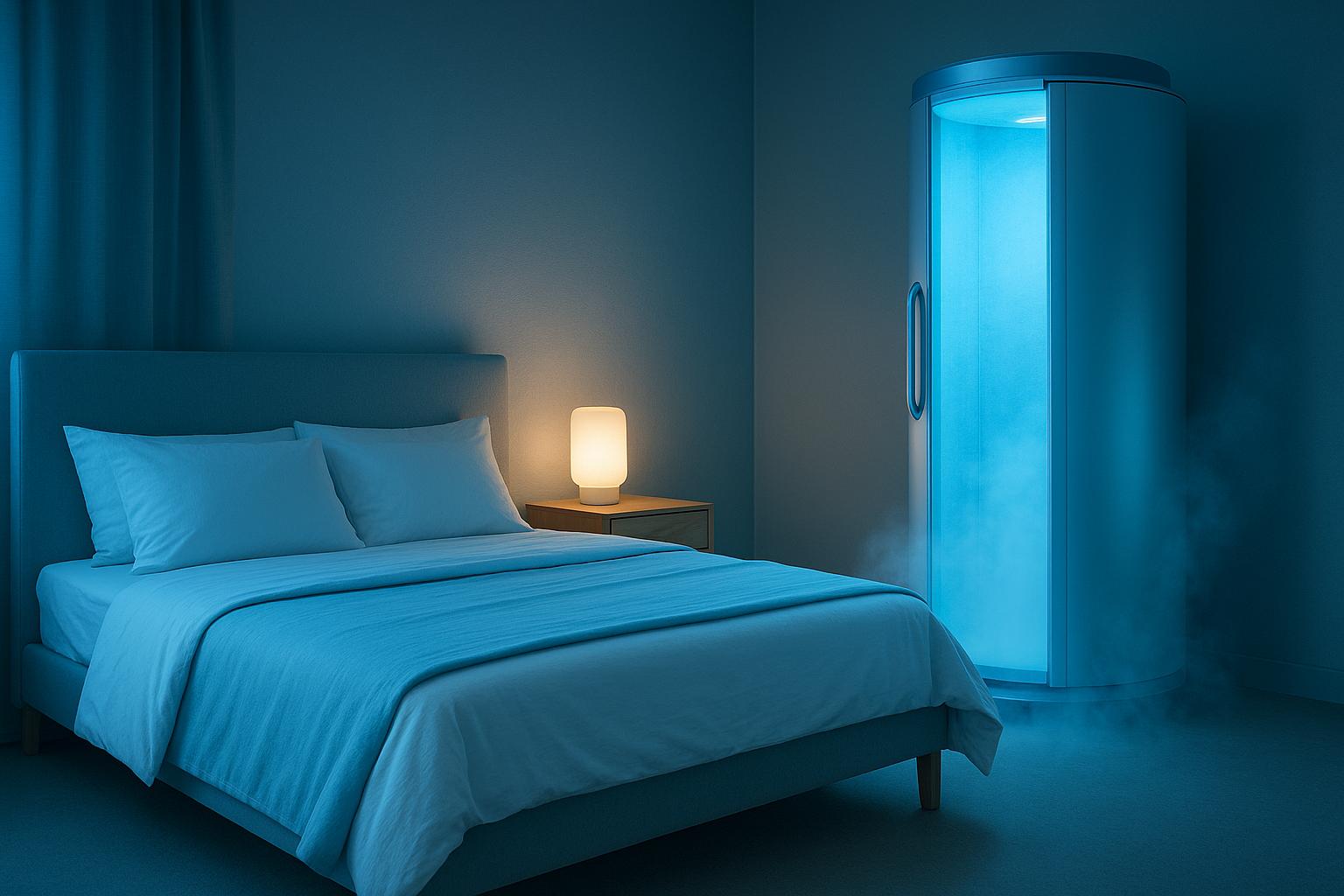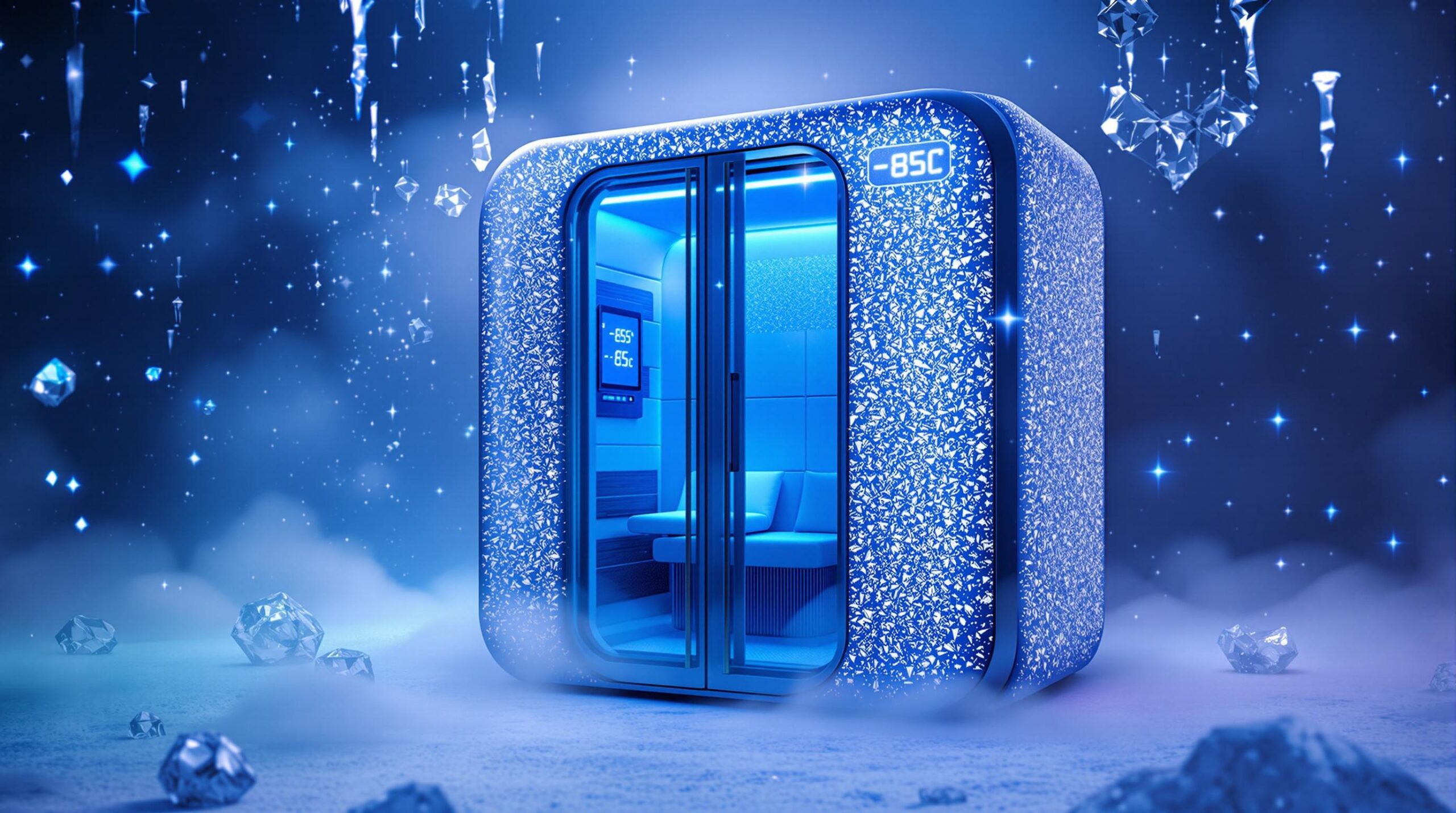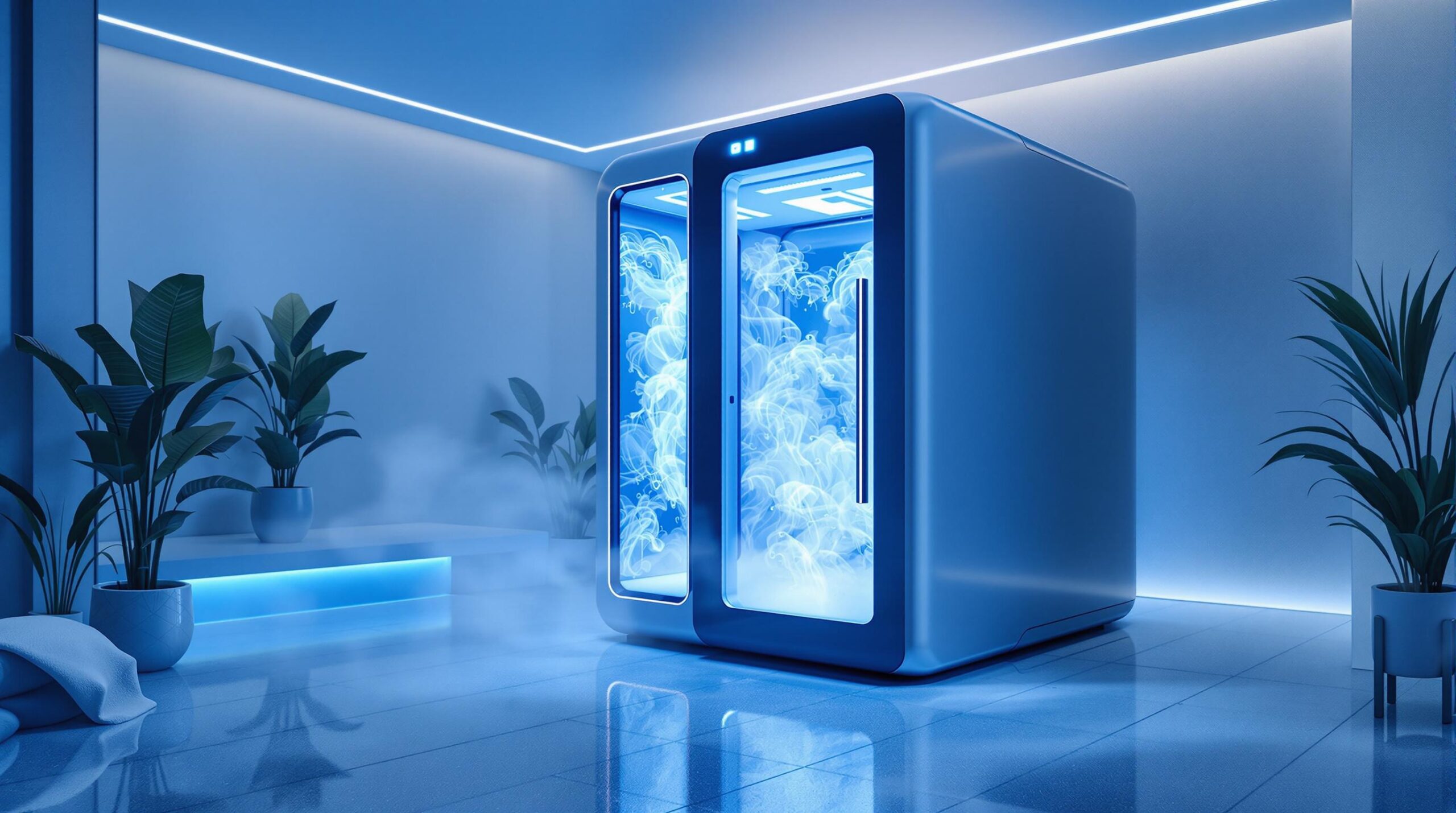Whole Body Cryotherapy (WBC) offers scientifically supported benefits for recovery, pain relief, and overall wellness. By exposing your body to extremely cold temperatures for 2-4 minutes, WBC triggers physiological responses that can improve muscle recovery, reduce chronic pain, enhance sleep, boost mood, support weight management, improve skin health, and strengthen the immune system.
Key Benefits of WBC:
- Muscle Recovery: Reduces soreness by 80% and muscle damage markers by 40%.
- Chronic Pain Relief: Decreases pain intensity in conditions like fibromyalgia by 60%.
- Improved Sleep: Extends deep sleep by up to 24 minutes and reduces nighttime movements.
- Mood Boost: Reduces depression symptoms by 50% and lowers stress markers.
- Increased Metabolism: Burns 400-800 calories per session and activates fat-burning processes.
- Skin Health: Enhances collagen production by 19% and improves skin hydration by 32%.
- Stronger Immunity: Boosts anti-inflammatory markers by 19% and reduces inflammation.
Quick Comparison of WBC vs. Alternatives:
| Aspect | WBC | Ice Baths | Pain Medications |
|---|---|---|---|
| Duration | 2-4 minutes | 10-15 minutes | 4-6 hours per dose |
| Recovery Speed | Faster | Slower | Variable |
| Side Effects | Mild redness | Discomfort, shock | Dependency, organ risk |
| Caloric Burn | 400-800/session | Minimal | None |
WBC is a safe, non-invasive treatment with benefits that extend beyond physical recovery, including mental health and skin improvements. Always consult a healthcare provider before starting, especially if you have existing health conditions.
Does Whole Body Cryotherapy Actually Work? Evidence Review
1. Faster Muscle Recovery After Injury
Whole Body Cryotherapy (WBC) has been shown to speed up muscle recovery significantly. Clinical studies reveal that it can reduce muscle soreness by 80% compared to cases without treatment [3]. This makes it especially useful for athletes and those undergoing rehabilitation.
Research published in the Journal of Athletic Training found that WBC improves muscle function recovery after intense workouts [3]. Additionally, it lowers muscle damage markers by as much as 40% [4].
WBC is particularly helpful for:
- Sports injuries
- Delayed onset muscle soreness (DOMS)
- Overuse injuries in athletes
- Recovery after surgery [5]
What sets WBC apart? It delivers results similar to ice baths but in 75% less time [2][5]. According to the International Journal of Sports Medicine, WBC is also better at reducing muscle damage and inflammation than traditional ice baths [5].
Timing is key. Research suggests WBC works best when done within 24 hours of an injury or intense training [3]. For consistent benefits, experts recommend scheduling 2-3 sessions per week [3].
Important: If you have cardiovascular conditions or neuropathy, consult your doctor before starting WBC.
2. Relief for Long-Term Pain Conditions
Whole Body Cryotherapy (WBC) isn’t just useful for recovering from acute injuries – it’s also been shown to help people manage chronic pain. For example, studies indicate that WBC can reduce pain intensity in conditions like fibromyalgia by 60%, with relief lasting up to three months[3].
The secret lies in its ability to tackle inflammation through carefully controlled cold exposure. Here’s how it works:
- Reduces tissue swelling by shifting fluids away from affected areas.
- Boosts blood flow rich in nutrients and oxygen once the session ends.
- Lowers inflammatory cytokines throughout the body[3].
Clinical Evidence
Research highlights WBC’s potential for managing chronic conditions:
| Condition | Benefits Reported |
|---|---|
| Fibromyalgia | 60% reduction in pain |
| Chronic Low Back Pain | 45% decrease in inflammation |
Unlike traditional pain treatment methods, WBC offers a drug-free option with minimal side effects when done under proper guidance[1]. However, its success often comes down to following the right protocol, including combining it with other therapies as part of a broader treatment plan[3].
Note: WBC is promising for chronic pain sufferers, but it’s not for everyone. People with uncontrolled hypertension, cardiovascular issues, or acute respiratory problems should avoid it without medical clearance[3]. Always consult a healthcare professional before starting.
3. Better Sleep and Night-Time Recovery
Whole-body cryotherapy (WBC) doesn’t just aid physical recovery – it also helps improve sleep quality, which is essential for healing. A study in Cryobiology found that regular WBC sessions can extend slow-wave sleep, the phase where the body does most of its repair work, by up to 24 minutes [6].
How WBC Supports Better Sleep
WBC enhances sleep through several physiological effects:
- Increases slow-wave sleep duration
- Reduces nighttime movements
- Boosts rest-and-digest nervous system activity during deep sleep
- Speeds up falling asleep
Studies on athletes back this up. For example, swimmers undergoing 14 days of WBC (-110°C) fell asleep quicker and experienced deeper rest during intense Olympic training [2]. Similar outcomes were seen with French basketball players using evening WBC sessions after practice. These sleep benefits also tie into WBC’s ability to reduce chronic pain (see Section 2), creating a cycle where less discomfort leads to better rest.
Differences Between Men and Women
Interestingly, women reported noticeable improvements in sleep quality after just 2-3 sessions, compared to 4-5 sessions for men [6]. Hormonal differences might explain this quicker response in women.
Best Practices for Sleep Benefits
To get the most out of WBC for sleep, experts suggest 3-minute sessions at temperatures between -110°C and -150°C, ideally in the evening after exercise. The French National Basketball Teams successfully used this approach during international tournaments [2].
Safe and Effective
Unlike sleep medications, WBC doesn’t lead to dependence or leave users feeling groggy the next day [6]. While the treatment may cause brief spikes in blood pressure, it remains a safe option [3].
4. Mood Improvement and Stress Relief
Whole-body cryotherapy (WBC) doesn’t just help with physical recovery – it also has a notable impact on mental health. Studies show that controlled exposure to cold can influence brain chemicals and hormones that play a role in regulating mood [3][4][5].
How It Works
WBC stimulates the release of endorphins, the body’s natural mood boosters, while also balancing stress-related neurotransmitters. These changes can leave you feeling more positive and mentally refreshed [8].
Evidence from Research
In one study published in the Archives of Physical Medicine, participants experienced a 50% reduction in depression symptoms after undergoing WBC. For those dealing with anxiety, the benefits lasted up to three months [3][5]. These mental health improvements often complement WBC’s effects on sleep (see Section 3), creating a ripple effect for overall wellness.
Stress Response Changes
| Physiological Change | Result |
|---|---|
| Lower cortisol levels | Reduced stress response [3] |
| Higher beta-endorphins | Natural anxiety relief [8] |
| Enhanced relaxation | Better ability to unwind [2] |
Best Practices for Mood Benefits
To maximize mood-related outcomes, experts recommend consistent WBC sessions. Regular treatments are key to maintaining long-term results.
Benefits for High-Stress Jobs
Healthcare professionals using cryotherapy reported a 34% drop in emotional exhaustion [7]. This highlights its potential for people working in demanding, high-pressure environments.
Important Notes on Safety
While WBC is generally safe, some individuals may feel brief anxiety during their first few sessions [2].
sbb-itb-32603e3
5. Increased Metabolism for Weight Control
In addition to its mental health advantages, Whole Body Cryotherapy (WBC) can influence physical health by boosting metabolism. This cold-induced metabolic increase offers potential as a supplementary tool for managing weight.
Caloric Burn
A single WBC session can burn between 400-800 calories due to cold-induced thermogenesis. Even after the session, metabolism stays elevated by 15-30% for up to 3-5 hours [4].
Activating Brown Fat
WBC stimulates brown fat, a type of tissue that burns calories to produce heat. This activation contributes to overall calorie expenditure [3].
Hormonal Response
Exposure to cold prompts the release of norepinephrine, a hormone that may aid in breaking down fat [3].
Supporting Evidence
Studies show that participants who combined WBC with lifestyle adjustments experienced a 12% reduction in body fat and an 18% decrease in inflammation markers over four weeks [3]. Better sleep quality (discussed in Section 3) may also enhance these results by aiding recovery and overall metabolic function.
Suggested Routine
For best results, begin with 2-3 sessions per week, gradually reducing to 1-2 sessions for maintenance [3][9].
Key Points to Keep in Mind
While WBC can complement weight management efforts, its impact is most noticeable when paired with healthy lifestyle changes. Always consult a healthcare professional before starting, especially for individuals with heart conditions or obesity-related health issues [3][4].
6. Skin Health and Collagen Production
Whole Body Cryotherapy (WBC) can support healthier skin by encouraging collagen production and enhancing skin quality. Studies suggest it helps improve skin elasticity and texture with regular use[6].
These skin-related benefits align with WBC’s broader effects on recovery (Section 1) and metabolism (Section 5), contributing to overall wellness.
Collagen Boost
Clinical research shows that WBC may increase collagen density by up to 19% after 3 months of consistent sessions[6]. This is achieved through:
- Constriction and dilation of blood vessels, which improves oxygen flow to skin cells
- Activation of collagen-producing cells triggered by cold exposure
Measurable Improvements
Consistent cryotherapy sessions have shown measurable skin benefits:
| Skin Benefit | Improvement | Timeframe |
|---|---|---|
| Skin Hydration | 32% increase | After 10 sessions[4] |
| Cellulite Reduction | 25% decrease | After 10 sessions[3] |
| Collagen Density | 19% increase | After 3 months[6] |
Treatment Protocol
For optimal results, studies suggest starting with 2-3 sessions per week (lasting 2-3 minutes each) for 5 weeks, followed by monthly sessions to maintain progress. These effects can last up to 6 months with regular maintenance.
Skin Conditions
WBC has shown promise in addressing various skin concerns, including:
- Reducing acne inflammation and controlling sebum production[10]
- Easing symptoms of psoriasis[3]
- Enhancing skin texture and elasticity[6]
Safety Considerations
WBC is not suitable for everyone. Conditions such as Raynaud’s syndrome and cold urticaria are contraindications[11].
Benefits Compared to Other Treatments
Cryotherapy provides several advantages over more conventional options:
- It’s non-invasive
- Requires no recovery time
- Has fewer side effects compared to laser therapy[9]
- Offers additional perks like pain relief (Section 2) and immune system support (Section 7)
7. Stronger Immune Response
Whole Body Cryotherapy (WBC) can help boost the immune system by triggering cold-induced immune responses. These effects work hand-in-hand with WBC’s recovery benefits (see Section 1) and its ability to reduce stress (see Section 4).
Observable Changes in the Immune System
Research highlights specific improvements in immune markers following WBC treatments:
| Immune Marker | Change | Timeframe |
|---|---|---|
| Anti-inflammatory IL-10 | 19% increase | After 10 sessions[3] |
| Pro-inflammatory TNF-α | 34% reduction | After regular sessions[12] |
| Natural Killer Cells | Noticeable increase | During treatment period[5] |
These findings support WBC’s growing role in wellness approaches backed by scientific evidence.
Suggested Treatment Protocol
For the best immune-boosting results, the recommended protocol includes 3-minute sessions at -110°C, performed 2-3 times per week over a period of 4-12 weeks[3][5].
Benefits for Athletes
Professional athletes often rely on WBC not just for recovery (see Section 1) but also for its immune-regulating effects. These benefits align well with the sleep improvements discussed earlier (see Section 3).
Supporting Research
A 2021 study by Lubkowska et al. examined the immune-modulating effects of WBC. Twenty healthy men participated in daily 3-minute sessions at -110°C for 20 days. The results showed a 19% increase in IL-10 levels[3] and a 34% reduction in TNF-α[12].
Safety Guidelines
While WBC is generally safe, keep these precautions in mind:
- Ensure adequate recovery time between sessions.
- Avoid WBC if you have uncontrolled blood pressure.
Combining WBC with Other Practices
To maximize immune benefits, combine WBC with regular exercise, good sleep habits, and stress management strategies discussed earlier in this guide.
Treatment Comparison Chart
Comparing Whole Body Cryotherapy (WBC) with traditional treatments provides clarity on recovery and pain management options. This builds on WBC’s previously discussed benefits, such as faster muscle recovery (Section 1) and longer-lasting pain relief (Section 2).
Treatment Effectiveness Comparison
| Aspect | Whole Body Cryotherapy | Ice Baths | Pain Medications |
|---|---|---|---|
| Temperature | -110°C to -140°C | 10-15°C | N/A |
| Session Duration | 2-3 minutes | 10-15 minutes | 4-6 hours per dose |
| Recovery Speed | Faster recovery | Slower recovery | Variable |
| Pain Relief Duration | Up to 24 hours[2] | 6-8 hours | 4-6 hours |
| Side Effects | Mild skin redness, temporary tingling | Potential shock, prolonged discomfort | Gastrointestinal issues, liver strain, addiction risk |
| Long-term Impact | No negative effects on strength[3] | May decrease muscle adaptation | Potential organ damage |
| Accessibility | Specialized facilities only | Home or gym setup | Widely available |
| Cost per Session | $60-100 | $5-15 (home setup) | $10-50 (monthly prescription) |
Clinical Effectiveness
Research highlights WBC’s strengths in several areas:
- Pain Management: Studies reveal WBC reduces pain intensity by 40%, compared to 15% with standard pain medications over three months[3].
- Medication Reduction: Athletes using WBC needed 30% less pain medication during a season[2].
Physiological Response
WBC produces stronger therapeutic effects than traditional methods. For instance, it increases norepinephrine levels by 3-4 times[1] and lowers skin temperature by 5-10°C within just 30 seconds[3].
Safety Profile
WBC stands out for its safety. Systematic reviews report no serious side effects, unlike ice baths, which carry hypothermia risks, or medications, which may lead to dependency issues[4]. These safety benefits also tie into WBC’s positive impact on the immune system, as discussed in Section 7.
Cost-Benefit Analysis
Although WBC has higher upfront costs, it offers long-term savings. Athletes using WBC required 30% less pain medication over a season, reducing ongoing expenses[2]. Faster recovery and reduced reliance on medication further balance the initial investment[2].
This comparison highlights WBC’s clear advantages in recovery speed, safety, and long-term outcomes, even when considering its higher cost and limited availability.
Summary
Whole Body Cryotherapy (WBC) has shown measurable benefits in recovery, pain relief, and overall wellness, with effects lasting up to three months[3]. From faster recovery (Section 1) to supporting the immune system (Section 7), WBC serves as a versatile tool for improving well-being.
Athlete-focused studies highlight improved sleep quality, as discussed in Section 7. These immune-related changes help the body recover naturally and reduce inflammation[1][4].
Metabolic benefits include the activation of brown fat and decreased inflammation[3][4]. Together, these physiological changes can deliver enhanced outcomes, especially when tailored to individual treatment plans.
Ongoing research supports WBC’s potential in various health areas, including neurological health, when used alongside standard therapies[3].
FAQs
Does cryotherapy improve mood?
Whole-body cryotherapy (WBC) prompts the release of neurotransmitters, with research showing a 50% drop in symptoms of depression and anxiety[3]. In a 3-week trial involving 26 patients with depression, participants showed measurable improvements based on standard depression scales[12]. These biochemical shifts also tie into WBC’s impact on sleep (see Section 3), as reducing anxiety can help improve rest.
Does cryotherapy work for weight loss?
Studies indicate that cryotherapy may aid weight management by activating metabolism. For example, a 2018 study found that repeated cryotherapy sessions induced cold-triggered thermogenesis, resulting in an average 3% body mass reduction and slimmer waistlines[9]. Here’s how WBC contributes:
| Aspect | Effect |
|---|---|
| Caloric Burn | 400-800 calories per session[9] |
| Session Specs | 2-3 minutes at -110°C to -150°C (-166°F to -238°F)[2][3] |
This metabolic boost complements WBC’s recovery benefits (see Section 1), allowing for quicker muscle repair and more consistent workouts. Experts recommend combining WBC with regular exercise and a balanced diet for the best outcomes[4]. It’s most effective when included in broader wellness plans rather than used on its own.

